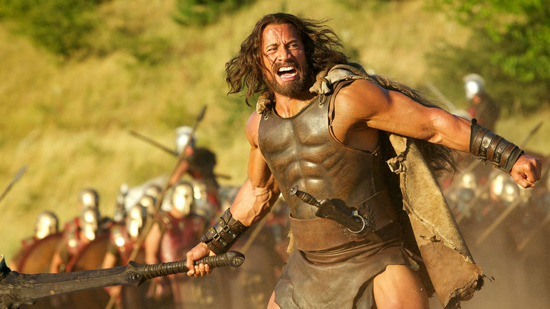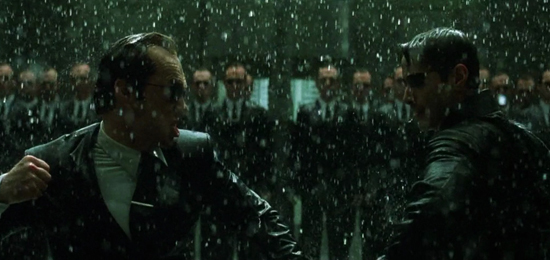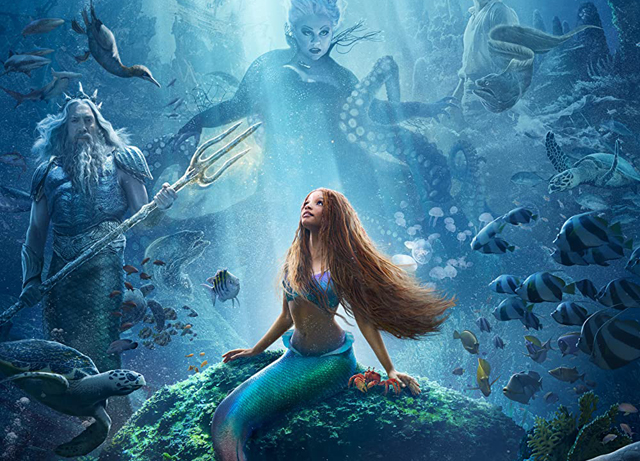
The Walt Disney Company is unlike the other big studios that make up Hollywood. While the likes of Universal, Warner Brothers, and Paramount built up their brands with their stables of stars and filmmakers, Disney came to prominence a different way. They had their own stars, but they weren’t dashing leading men or entrancing leading ladies; they were cartoons. Begun a century ago in the back of a tiny law office in the Los Feliz neighborhood of Los Angeles, The Disney Brothers studio was born and out of that tiny back room grew one of the most powerful media empires the world has ever known. Now the Disney Company has expanded to include other valuable brands like Star Wars, Marvel, 20th Century Studios, as well as having a major foothold in theme parks and even it’s own cruise line. But, even with all that growth, Animation is still at the core of the studio. The character of Mickey Mouse undoubtedly was responsible for making Disney what it is, but what has also come to define Disney over it’s 100 years are their historic milestones that pushed the medium of animation further. Not every invention in animation can be credited back to Disney, but they are responsible for mainstreaming innovations. It was going to be inevitable that someone would attempt a feature length animated film, but it took the initiative of Walt Disney and his artists to actually take that first step, even when many in the industry thought he was crazy. Snow White and the Seven Dwarves (1937), their first feature film, sparked a revolution in the art of animation, and all that followed for Disney can be attributed to that success. In the 85 years since Snow White, the Disney Animation Studio has produced 61 feature films, with the upcoming Wish (2023) marking their 62nd this November. This group of films has come to be known as the Disney Canon; an official grouping of films linked back to Snow White and meant to stand apart from all the rest of the films made at Disney.
In the Disney Canon, there are six distinct eras; the Golden Age (1937-42), the War Years (1943-49), the Silver Age (1950-67), the post-Walt Dark Age (1968-88), the Disney Renaissance (1989-2004) and the Digital Age (2005-present). From all of these names, you can imagine the different shifts the Disney company went through, and the movies released in these eras are very much reflective of that. The Golden, Silver, and Renaissance years were times of incredible growth and prosperity for Disney, whereas the War Years and the Dark Age were very disruptive. But even during those disruptive years, Disney still produced a lasting classic every now and then, like The Three Caballeros (1945) in the War Years, and Robin Hood (1973) in the Dark Ages. Looking over all of the Disney Canon films, it really is interesting to see the evolution of animation playing out before you as each film is it’s own time capsule. And in many of the films, there are moments that remain iconic no matter what age it is. These are the moments that stick with us for years afterwards and they are also the moments that have come to define the Disney name in the pop culture. What follows is what I think are the Top Ten Moments from Disney Animation that have appeared so far throughout the years. I’m drawing solely from the Disney Canon and at 9 decades and 61 films worth of material to go through, there are some tough choices about what to leave in and out. So, with all that said, here are the Top Ten Disney Animation Moments..so far.
10.

MULAN VS. THE HUNS from MULAN (1998)
Disney is most well known for their lavish, Broadway style musical numbers and slapsticky cartoon hijinks. What they are less well known for is staging epic battle scenes. Sure, there have been climatic one-on-one battles, but a harrowing battle featuring armies numbering in the hundreds is something very out of character for them. That’s not to say they couldn’t do it; all they needed was the right story. They eventually found such a story with the Chinese legend of Mulan, the girl who impersonated a man in order to join the army. The movie Mulan does an admirable job at building a captivating story around it’s heroine, but where the film really excels as a work of animation is in it’s staging of it’s more epic moments. The film made use of the studio’s new innovative computer enhanced animation tools, which included the ability to fill a scene with literally hundreds of characters with a crowd simulator. The most amazing use of this tool is found in a harrowing battle scene on the slop of a mountain. Drawing inspiration from filmmakers such as David Lean and Akira Kurosawa, this battle against the Huns showcases a level of scale and scope never seen before in a Disney animated film, or any animation up to that point in fact. You really get the sense of the overwhelming odds on screen, as the villainous Shan-Yu leads the charge down the slope, followed by all of his soldiers spilling over the crest on horseback in a seemingly unending horde. Impressive as the effect is, the movie also gives us a surprising twist as Mulan uses her quick witted thinking to defeat the enemy single handedly, by launching a cannon at the mountaintop, causing an avalanche. To this day, even with all the advances in computer animation, this scene still manages to wow, mainly because of the epic way it is staged. You really get the sense of scale that Disney’s animators were trying to go for, and as a result, it shows that they could do so much more than just the cartoon stuff.
9.

FAIRY GODMOTHER’S GIFTS from CINDERELLA (1950)
The movie that sparked the beginning of Disney’s Silver Age is also one of the more grounded of the era. Sure, talking mice is a fanciful touch, but Cinderella’s dilemmas are much more grounded in reality than the typical Disney fairy tale narrative. Our heroine is not under some curse, or is the key to solving a magical riddle. She is a poor soul being tortured and humiliated in her own home by a wicked Stepmother and her vain step-sisters. Where the fairy tale element of the story comes in is at the moment Cinderella hits her lowest point; after the step-sisters have torn her dress to shreds, preventing her from attending the Royal Ball. As she loses all hope for happiness, that’s when the Fairy Godmother arrives and works her magic. The whole scene that follows is pure Disney magic, as the Fairy Godmother gifts her a full royal entourage out of all the animals in the garden and a magnificent carriage out of a pumpkin. Set to the memorable tune of “Bibbidi Bobbidi Boo,” the whole sequence is a delight, but it reaches it’s high point when the absent minded Fairy Godmother finally remembers that Cinderella is in need of a dress. And the moment Cinderella’s dress forms out of the rags of the old one may just be one of the most iconic single moments in animation ever. Drawn by the iconic animator Marc Davis, one of Disney’s notable Nine Old Men, this moment really shows you what animation is capable of in contrast to any other form of filmmaking. Any live action effect, especially in that time, couldn’t effectively do the same as what animation was capable of in realizing that moment, from the swirling of magic dust all around her to how the dress itself forms fluidly from the rags that Cinderella is wearing. And it’s an iconic dress as well, complete with the all important glass slippers. It may not be one of Disney’s flashiest moments, but it is one of the most magical.
8.
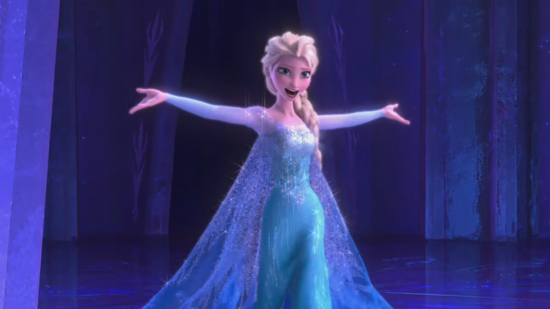
THE ICE PALACE FORMS from FROZEN (2013)
The Digital Age of Disney Animation is one that is still trying to find it’s identity compared to eras of the past, and for many die hard Disney Animation fans, they have a harder time finding things to love about computer animation when contrasted with the hand drawn films. But there are certainly moments that are too good to ignore from this period in time, and one of the most iconic naturally comes from the biggest hit of this era. The movie Frozen is noteworthy in the Disney Canon for a lot of things, but the moment that everyone remembers in the film is the show-stopping musical number “Let it Go.” After fleeing her kingdom and finding herself in exile in the chilly mountains that border those lands, Queen Elsa resolves to cast aside the fear and self-loathing that caused her to hide her ice-based power for so long. In doing so, she finally gives herself the motivation to “let it go” and take her power to the extreme without any inhabitations. The song itself is quite the uplifting number, but the sequence definitely reaches it’s high point when Elsa begins to create a palace of ice on the mountain peak. Shown in an incredible one shot, we see the foundations of the palace rise right out of the snowy slopes, followed by the cathedral like walls and then finally in a magnificent snowflake chandelier. The way the virtual camera floats through this whole sequence is what really makes the scene special, putting us right in the middle of the magic. And even after that breathtaking tracking shot, we get another magical moment as Elsa uses her power to change her royal garb into a icy blue and white gown. Out of all the movies of the Disney Digital Age, this is the moment that still rings out as iconic almost a decade later, and it easily stands as one of the most memorable in the Disney Canon.
7.

LOVE’S FIRST KISS from SNOW WHITE AND THE SEVEN DWARVES (1937)
It would be wrong to overlook an iconic moment from the movie that started it all. When Walt Disney first proposed to make a feature length film at his studio, many in Hollywood thought he was crazy. “Disney’s Folly” is what they called it, and there were several in the industry that believed it was impossible to hold an audience’s attention for more than the average 7-10 minutes when it came to animation. But, Walt Disney persisted, believing quite rightly that this was the future of the medium. His team of animators pushed themselves to innovate and take animation in a direction that could believably support such a monumental project. In the end, they managed to go above and beyond, with Snow White not just showing that a feature length animated film was possible, but that it’s story could rival anything told in live action. The animators really got a sense of how successful they were when they attended the film’s premiere at the Carthay Circle Theater in Los Angeles. At the climax of the film, Snow White is put into a death like sleep by a poisoned apple given to her by her step mother, The Queen, in the disguise of a hag. The Seven Dwarves eventually chase down the Queen, who receives her comeuppance falling off a high cliff, but they return home believing their beloved Snow White is slain. They chose not to bury her, instead placing her in a glass coffin in the forest, where the Prince pays her a visit to share his own grief. He gives her a kiss, and this act magically revives the sleeping Snow White, leading to a triumphant celebration. What struck the animators at the premiere was that they were seeing members of the audience, including A-List stars, openly weeping in the theater. One of Disney’s animator’s, Ward Kimball, recalled the moment in amazement, realizing that what the audience was crying at was just a stack of drawings. This showed that Disney transcended the medium of animation and could tell a story as captivating as any other made in Hollywood. These were no longer just drawings; they were fully fleshed out characters whose stories could make you forget that you were watching a cartoon.
6.
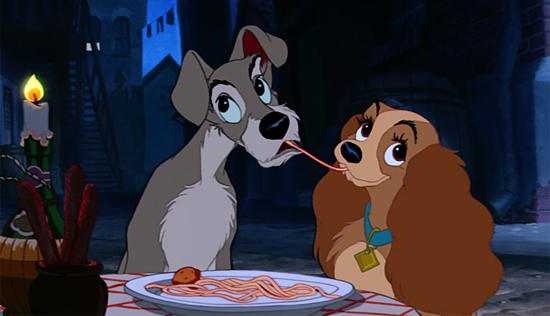
THE SPAGHETTI DINNER DATE from LADY AND THE TRAMP (1955)
Sometimes the most magical moments in Disney movies don’t have to have actual magic. Sometimes it can be something as simple as a Spaghetti and Meatball dinner. That’s the case with this iconic moment from Lady and the Tramp. The movie is one of Disney’s more grounded films, with a simple love story told from the point of view of dogs. Lady is a cocker spaniel from a nice neighborhood, while Tramp is a mangy mutt from the rough side of town. Circumstances bring them together, as Tramp helps Lady remove a muzzle forced on her by a cruel new caretaker. Still far from home and afraid to return, Lady needs some guidance, so Tramp agrees to show her around town. Eventually they arrive at Tony’s Restaurant, one of his favorite haunts where the namesake owner is always happy to give him a handout. Upon seeing that Tramp this time has company, Tony has the idea to give the two more than just scraps. Tony gives them a full spaghetti dinner, complete with candlelight ambiance and Tony and his assistant Joe giving them a musical serenade. In the real world, this would all be absurd, but in the hands of Disney’s animators it becomes one of the most romantic moments in cinema history. The song, “Bella Notte” is itself a beautiful tune, and it perfectly sets the tone for the scene. Of course the iconic moment that everyone remembers is when Lady and Tramp both start to chew and swallow the same strand of spaghetti, causing their heads to be pulled closer together until they lock lips. Lady bashfully looks away and Tramp gallantly pushes a meatball closer to her. The moment is so subtle and beautiful, and one of the most sublimely romantic moments ever put on film. And it’s all the more remarkable that they are doing this with dogs as the main characters. It’s a far more mature take on finding love than the standard fairy tale love at first sight. Here, we see love bloom in the most unexpected way, and it’s a moment that still continues to delight many years later.
5.

WILDEBEEST STAMPEDE from THE LION KING (1994)
The Disney Renaissance marked a high point for Disney Animation. After languishing in the Dark Ages of the post-Walt Disney years, Animation made a triumphant return with the release of The Little Mermaid (1989). Of the Disney Renaissance films, none was bigger than The Lion King, a film that truly showed that Disney had grown bolder in it’s storytelling during this transformative era. The Lion King was epic in scale, showcasing the vast wilds of the African savannah in a majestic tapestry of beautiful naturalistic animation. It very much was a Disney film in the grand tradition that came before, but it also was innovative in a lot of other respects. Computer animation had been coming a long way through the other films prior in the Renaissance Era, but in The Lion King, they created one of the most complex scenes that had ever been done in animation. With the intent of killing both the king and his son in one fell swoop, the deceiving villain Scar lures his nephew Simba into a trap, unknowing of the peril he’s about to get into. Simba is brought into a canyon where a huge herd of wildebeests are forcibly chased into, creating a stampede in which Simba is right in the path of. The moment is truly terrifying, as the Disney animators used for the first time a duplication software that allowed them to create a limitless amount of wildebeests, making the horde heading Simba’s way to be an overwhelming force. It’s the same software used in the battle from Mulan, but here it’s even more impactful. When the wildebeests begin to crest over the ridge of the canyon, you get the feeling of dread of an oncoming storm, and the filmmakers punctuate that moment with a simulated smash zoom onto Simba’s terrified face. Simba’s father Mufasa does eventually save him, but he’s overwhelmed by the sheer force of the wildebeest’s size and numbers. Scar of course sabotages Mufasa’s escape, and it leads to one of the few on screen deaths in a Disney animated movie. Though The Lion King has it’s fair share of iconic scenes, this is the one that has come to define the movie as an all time classic.
4.

THE CAVE OF WONDERS from ALADDIN (1992)
The Lion King may have been the most epic scale film of the Disney Renaissance era, but for the most action packed scene of this Age, you’d have to watch the movie that preceded it. Aladdin is a magnificent ode to Golden Age Hollywood, with it’s incredible mix of high adventure, iconic music, and a general sense of campy fun. In the most harrowing part of the film, Aladdin, deemed the “diamond in the rough,” is sent to retrieve a magical lamp from the Cave of Wonders. The cave itself is vast and treacherous and Aladdin eventually finds the lamp high on a pedestal above a subterranean lake. He takes the lamp, believing the worst is over, until he sees his monkey companion Abu trigger the self-destruct trap of the cave. Massive boulders fall from the ceiling and the lake turns from water to lava instantly. With the help of the Magic Carpet, Aladdin and Abu have a means to escape, but the lava lake magically follows after them in a fearsome tidal wave. The flight through the cave itself is the moment that sets this scene apart. While Aladdin and Abu are still hand drawn, their environments were completely rendered in computers, creating a 3D environment so complex it became immersive. Sure it looks graphically primitive today; coming across just slightly more complex than a CD-ROM era video game, but in the early 90’s, this was ground-breaking. Disney’s CGI team apparently looked to flight simulators, such as the one found in the Star Tours ride at Disneyland, for inspiration for this sequence, and it shows. The flight through the cave definitely feels like you are on a ride with the characters, and it was a brilliant way to use computer graphics in a traditional animated film, helping them to do things that never had been seen before. And it also fits well within the film’s whole general sense of fun. Aladdin is a film full of moments that boldly pushes the limits of animation, and the Cave of Wonders sequence is where you especially see the film take things to it’s wildest and most edge of your seat potential.
3.

MAN IN THE FOREST from BAMBI (1943)
Moving to a completely different tone in Disney Animation, there is one other thing that the studio has excelled at and that’s pulling at the heartstrings of it’s audience. There are some definite heart-breaking moments in their movies, like the aforementioned death of Mufasa in The Lion King, or the reunion scene of Dumbo and his mother in Dumbo (1941). But, if there was ever a moment in a Disney movie that left a scar on the hearts of generations of children, it’s the fate of Bambi’s Mother in the film Bambi. Throughout the movie we are told of the ominous threat of “man” in the forest. The incredible thing about the film is that you never once see a single human being, at yet their foreboding presence is felt throughout. The only trace they leave in the film is the sound of a gunshot. And that sound itself plays a very key role in the moment that defines this film. On a seemingly normal morning, Bambi’s mother leads him to a fresh patch of grass they can feed on in the midst of a snowy field. As they feast, the “man” theme begins to creep into the score. Bambi’s mother’s sense flare up, and she tells her son to quickly run to shelter. Bambi runs ahead, with his mother motivating him onward, and then “bang.” Bambi makes it to the shelter unharmed, but he made it alone. He heads back out just as a flurry of snow begins to fall, calling for his mom. After a fruitless search, Bambi runs into the Great Prince of the Forest, his father, who sadly confirms his worst fear, that he won’t be seeing his mother anymore. This was a shockingly harsh moment for a Disney film to have, especially in it’s early days. Unlike so many of their other films, this one delivered a harsh truth about the real world. Bambi’s mother was not going to come back through any type of magic; she was just gone and never coming back. A lot of children probably learned a lot about mortality and dealing with grief from this moment in the film. Disney has a history of tugging at heart-strings, but none broke our heart as much as this moment did.
2.
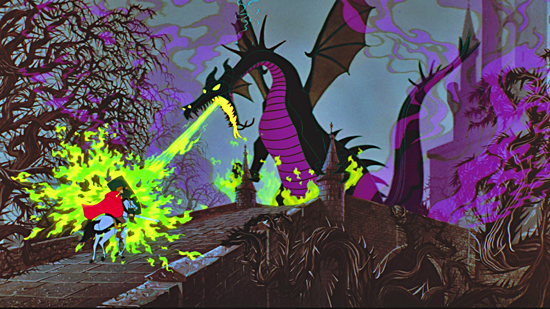
THE DRAGON BATTLE from SLEEPING BEAUTY (1959)
The Silver Age of Disney came at a time when Hollywood was changing as a whole, embracing big widescreen epics as the answer to the rise of television. Disney likewise embraced the widescreen medium as well, applying it to animation in innovative ways. Lady and the Tramp was the first official widescreen film for Disney, but it was shot in that format in a last minute change-up, with much of the compositions on screen not really designed for the full wide frame. Their follow-up, Sleeping Beauty would on the other hand be designed for widescreen from the get go. And there are some incredible moments that beautifully utilize the full dimensions of the wide frame. Of course, the one that stands out the most is the climatic battle at the end of the film, between Prince Phillip and the Mistress of All Evil herself, Maleficent. The movie’s climatic battle, which sees Maleficent transform into a massive fire-breathing dragon, has become something of a gold standard for epic climaxes in other Disney movies. You can see the battles against Jafar as a giant cobra in Aladdin and against Ursula as a giant version of herself in The Little Mermaid having been inspired by the battle against Maleficent’s Dragon in this movie. It is a harrowing climax to a sequence that had already seen Phillip and the good fairies escape from giant rolling boulders, fireballs from the sky, and a forest of razor sharp thorns. And the widescreen frame makes it feel even more grandiose, especially if you see this on a big screen. The use of color in this scene also helps to heighten the tension, as the sky turn from somber grey to bright yellow as Maleficent’s inferno engulfs the whole scenery. The dragon is only on screen a short while, but every second she’s there it is memorable. The image of Prince Phillip tossing sword against a lunging dragon across the bright yellow sky is by itself a still image as great as any medieval work of art, and a perfect showcase of Disney Animation at the peak of it’s power.
1.

THE BALLROOM from BEAUTY AND THE BEAST (1991)
All of the moments on this list left a lasting impression in it’s own way on both the film they were in as well as the era that they represented. But there is a moment in Beauty and the Beast that exemplifies all of the tricks of the trade that Disney had built up to that moment in time all working together to create a truly pure cinematic moment that just stands above all in animation. Set to the melody of the title song, Beauty and the Beast brings the film to another level as the two characters make their way to the ballroom. Aladdin and The Lion King both had incredible moments that showcased incredible integration of CGI into traditional animation, but none were as sublime as what they accomplished with the ballroom scene in this film. The way that the camera sweeps across the floor with Belle and the Beast and then shoots up into the ceiling is breathtaking, as is the spiral downward from the chandelier back down to the floor. The moment is both complex and subtle at the same moment. The computer animation team knew they could create even more dynamic camera movement, like they would eventually with the Cave of Wonders in Aladdin, but here it’s restrained enough to wow us, but also feel natural in it’s sweep. The scene after all is meant to be romantic. The camera’s trek in a way mirrors the balletic movement of the dancing duo. And the integration of the traditionally animated characters into this three dimensional space is impressive, even by todays standards. Here we see animation taken to it’s cinematic power. It’s interesting to note that the filmmakers were unsure that they could pull the scene off, and even had a back up plan called the “ice capades” version, where Belle and the Beast would dance in complete darkness with a spotlight following them. Thankfully the rendering of the 3D Ballroom worked out, and we have this iconic moment presented in it’s full glory. Beauty and the Beast was the first ever animated film nominated for Best Picture at the Oscars, and it probably helped that this iconic wow moment left so many audiences so enchanted by the film. It may not have been the most exciting scene in a Disney film, but it is definitely the scene that showcased the animation studio working all of the knowledge of their long history of innovation into a pure cinematic moment.
So, there you have my picks for the most iconic moments in the first 100 years of Disney animation. There were certainly many other moments that I wish I could’ve included, like the “Hellfire” sequence from The Hunchback of Notre Dame (1996), the Wizards Duel from The Sword in the Stone (1963), The Sorcerer’s Apprentice casting his first spell in Fantasia (1940), the Pink Elephants from Dumbo, Ariel hitting her high note with a wave crashing behind her in The Little Mermaid, the Big Ben fight in The Great Mouse Detective (1986), the flight to Neverland in Peter Pan (1953), and the escape from Monstro the Whale in Pinocchio (1940) to name a few. Suffice to say, there is a proud legacy of iconic cinematic moments that have come out of the Disney Animation studio. The moments that stand out the most however are the ones that surprise us the most, like the Ballroom from Beauty and the Beast, or the Spaghetti Dinner from Lady and the Tramp. The death of Bambi’s mother is also one where the sheer brutality of that moment hits incredibly hard, making it memorable in a way that transcends the artform and makes us consider the morale meaning behind what we saw in that moment. And of course, there are those moments that we remember because they just felt magical, like the moment when Cinderella gets her stunning ball gown. Disney Animation just has that special ability to connect with their audience, and it’s managed to stay strong through a tradition of excellence and imagination that goes all the way back to when Walt and his tiny team of animators were working out of that back room in Los Feliz. Hopefully that spirit of innovation and imagination continues to remain strong going into their second century. For now, we have a long legacy of exceptional animated art from the most storied animation studio in the world, with a canon of films 61 one strong and growing.








